Uffizi Artists | Location | Opening Hours Tickets | Authorizations
Artists Botticelli | Michelangelo | Da Vinci | Caravaggio | Raphael | Titian | Giorgione | Medici | Dürer Cranach Memling | Credi Bartolomeo | Rubens
Michelangelo:“The Holy Family” the “Tondo Doni” at the Uffizi in Florence
“The Holy Family” by Michelangelo: A round picture
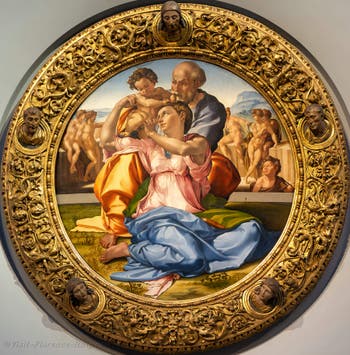
The Holy Family The “Tondo” Doni is called “Tondo” because it is a rounded picture.
This picture painted with fatty tempera on wood represents the Holy Family: the Virgin Mary, Mother of Jesus, raises her arms to receive the Child from her father's hands under the tender gaze of little John the Baptist, dressed with animal skin.
Behind them, we can see five young men posing naked like the beautiful statues of Greco-Roman antiquity.
These naked men represent the pagan world, the Old World turned upside down by the appearance of God on earth in the form of the Child Jesus charged with a particular mission.
It is Michelangelo's oldest painting.
It was painted between 1504 and 1506 on a commission from Angelo Doni, a wealthy Florentine merchant who wanted to offer his wife, a beautiful image of the Holy Family.
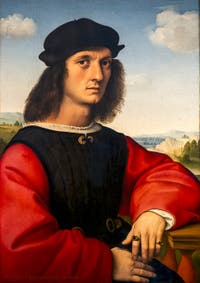
Raphael, Angelo Doni The “Tondo Doni” is presented in its original frame, specially designed by Michelangelo and made under his direction by a Sienese craftsman.
In January 1504, Angelo Doni married Maddalena, a young girl from the Strozzi family, the great rival of the Medici.
To honour him, Angelo Doni had the three crescent moons sculpted back to back, representing the weapons of the influential Strozzi family and five very different heads on the frame of the painting.
The top one would be that of Christ. The other four could represent saints or members of the Doni and Strozzi families other than the newlyweds.
For the birth of Marie Doni Strozzi
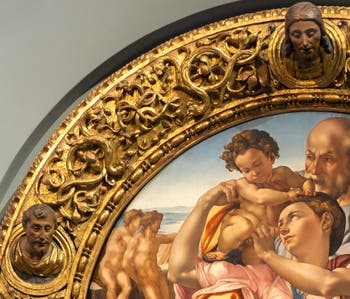
The Holy Family The Doni couple hoped to have a child. This painting of the Holy Family commissioned by Angelo would be a birth gift.
The long-awaited Child was finally born on September 8, 1507, the feast of the Nativity of Our Lady.
A happy coincidence indicated that she had fulfilled their wish by giving them a little girl, whom they called Marie, as it should be.
The natural and the supernatural of Michelangelo's “The Holy Family”
We are immediately struck by the dynamism and the strong presence of the three characters who make up this family, whose mother is in the foreground, and of whom no one wears the halo indicating holiness.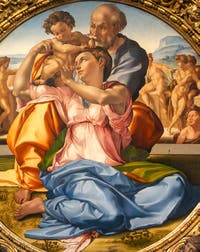
The Holy Family Marie is dressed simply: Dressed in a Greek tunic belted under her chest, her legs draped in her cloak, she does not wear a veil over her head.
Sitting on her heels, this sculpturally beautiful woman sketches an elegant rotation of her bust by raising her arms to receive Jesus carried by her father.
Marie's right arm frames and protects the Child, who takes the initiative by lifting one leg.
And we can see that the little foot slumped under the weight of this beautiful, chubby baby, leaning on his father with his decidedly pouting and putting his hands on his mother's head to come and settle into his lap, are indicative of his strength, and of his desire to go to the forefront.
He is the one who determines the actions of his parents: he leaves his father, who is watching him with his eyes and giving him support, while his mother turns around, raising her eyes and arms at him to welcome him as soon as he passes by her side.
The Holy Family Trinity in Michelangelo's “Tondo Doni”
The father looks at the son, and the son looks at his mother, who looks at his son with love, ready to receive him.
The Holy Family United by the love that drives them, the three heads form a triangle.
This beautiful trinity of the Holy Family is underlined by the Child's solitude, who can be seen backwards to the right of the painting, following the line of his melancholy gaze that connects him to Jesus.
This Child, dressed with animal skin with his little cross on his shoulder, it was the Jewish prophet John the Baptist who, as an adult, baptized Jesus in the Jordan River by saying, “Here is the Lamb of God.”
In the New Testament, Saint John the Baptist is the ascetic who preaches penance and announces the Passion of Jesus, who, like a lamb, will agree to be sacrificed by dying on the cross to atone for the sins committed by mankind since Adam and Eve.
Michelangelo: Humanity of Ancient Times
This ancient humanity is represented by the five naked men in the background.The intermediate position of Saint John the Baptist shows that he symbolizes the transition from the age of the ancient law of Moses to that of Redemption with the arrival of God on earth.
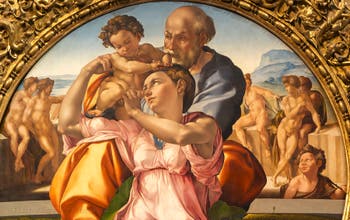
The Holy Family A clearly visible line separates them from the Holy Family, a starting line because the birth of Jesus inaugurates the Christian era, which is the time of Redemption for all humanity.
As a result, the beautiful Child Jesus with his headband appears to be an admirable little athlete of the Faith encouraged by his father and adored by his mother.
She welcomes him after having closed the Book of Ancient Scriptures placed on his lap.
A new era begins with the life and Passion of Jesus Christ described in a new book: the Holy Gospels.
The beauty of “Tondo Doni” undoubtedly comes from this mixture of family intimacy with the greatness of the Christian mystery: God appeared on earth in the form of a living child.
Michelangelo and Leonardo da Vinci: the rivalry creating masterpieces
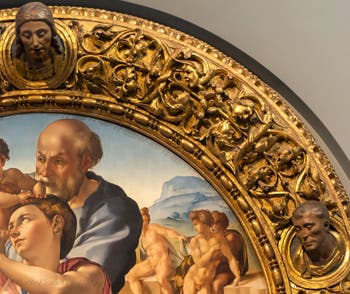
The Holy Family In the 15th century, Florentine merchants commissioned paintings evoking family life: it was the golden age of the Madonnas and the Virgos with the Child, but the Virgin had come to look like a wealthy patrician.
The preacher Savonarola had severely criticized this amalgam of sacred images with those of real, richly dressed women while accusing painters of introducing vanity into churches.
By the end of the 15th century, some painters had abandoned splendour and luxury to express the characters' state of mind.
Leonardo da Vinci and the Virgin Mary
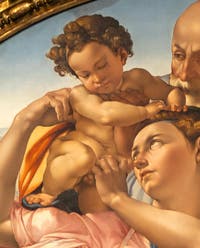
The Holy Family This was the case with Leonardo da Vinci, whose “Madonna of the Rocks” and “The Madonna and Child with Saint Anne” revealed the inner drama of Mary: by maternal instinct, Mary tries to distance Jesus from the symbol of the Passion.
At the same time, a representative of the divine will prevents her from doing so and thus forces her to accept the announced sacrifice.
In 1501, while Michelangelo was sculpting his famous David, Leonardo da Vinci presented to the public a box on which he had made a magnificent sketch of his future “Madonna and Child with Saint Anne”, as described by a monk of the time:
“It represents the Child Jesus, about one-year-old, who seems to be leaving his mother's arms to take a lamb and hug him.
The mother, who would have been said to be sitting on Saint Anne's lap, tries to separate the Child from the lamb, a sacrificial animal that symbolizes the Passion.
Saint Anne gets up in turn as if to restrain her daughter and prevent her from separating the Child from the lamb: an image that could be that of the Church that does not want to be prevented from happening.”

The Holy Family Leonardo da Vinci had abandoned the melancholic sweetness of the Virgos of his time: his drawing expressed all the mystery of a complex state of mind, the movement and the mixture of feelings of the woman who saw the conflict between the natural and the religious.
The Florentines lined up to admire this sketch (unfortunately lost), where the naturalistic vision of the famous Leonardo illuminated religious personalities in an entirely new light.
In 1504, they were dazzled by the extraordinary beauty of Michelangelo's David, who was about to paint his “Tondo Doni”.
The “Tondo Doni” will be a humanist response to Leonardo da Vinci's naturalistic and psychological vision of religious data.
Michelangelo's Holy Family: The power of shapes and the brilliance of colours
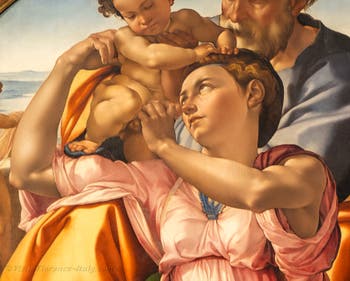
The Holy Family The Virgin of the “Tondo Doni” radically differs from the Marian typology of the 15th century.
Her calm face and bare, muscular arms used for domestic work show us an ordinary young woman in total health.
The folds of her intensely coloured clothes reveal the flexibility and natural elegance of this young mother who acts with ease, turning around to welcome her energetic Child.
Michelangelo and the image of Joseph in the Holy Family
Behind the Virgin, the monumental presence of the father, who envelops her with his knees as wide and stable as columns, corresponds more to the image of God the Father Almighty than Joseph's.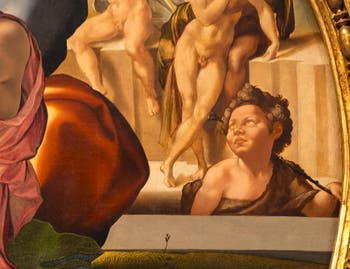
The Holy Family Indeed, Joseph was usually seen as a secondary character because he was “only” Jesus' foster father, always placed at a distance from Mary.
Traditional images of the Holy Family showed him asleep or contemplating the Child.
And although he was given greater prominence at the end of the 15th century, he remained separated from Mary; this impressive proximity was enough to surprise Michelangelo's contemporaries.
Proximity that they could interpret as an illustration of the power of the Creator with his creation: Mary is a human being, a pious woman obeying the divine will.
Michelangelo's Holy Family: Unity and light
Artists Botticelli | Michelangelo | Da Vinci | Caravaggio | Raphael | Titian | Giorgione | Medici | Dürer Cranach Memling | Credi Bartolomeo | Rubens
Uffizi Artists | Location | Opening Hours Tickets | Authorizations
Back to Top of Page

